
John SIlvis in his Williamsburg studio
photo: Andre Wagner
Alejandro Jassan with John Silvis
The contemporary art world has become much more complex in the past few years, forcing its players to redesign the role they each will take; artists become dealers, curators become collectors, and even mainstream pop stars become critics. Nonetheless, there has been a beacon of hope in artist-run spaces, where programming goes beyond the sales point and offers an outlet (no pun intended) of creativity for emerging practitioners.
Alejandro Jassan: John, can you please explain your transition from artist to curator, and furthermore your transition into a dealer at OUTLET? After seeing both sides of the coin, how do you take on a different approach to running a gallery?
John Silvis: I think that many roles in the art world overlap, but to me the approach is very similar to all of them… the dynamics and the details of each role might be different. The transition from artist to curator happened very naturally because I met a lot of artists and wanted to not only show my work, but show their work as well. It was a natural extension of what I was doing and I like being part of a community. The transition from curator to having a gallery is mostly that now you have a business to run. I make my decisions both as a dealer and as a curator, based on work that I think is important. As a dealer I do not choose a work because it will sell, but in terms of practical aspects I think more about the viability and longevity of the work.
AJ: OUTLET is definitely in good hands. Jason Andrew is a very celebrated curator and producer, not to mention his essential role in the Bushwick art scene. On the other hand you have Julian A. Jimarez Howard, an entrepreneur that associates himself with some groundbreaking projects, including Associated Gallery. Can you tell me more about your role at the gallery, and how did you get involved with it?
JS: I met Jason through his Norte Maar space. When Jason came to Bushwick about six or seven years ago and opened the space there weren't really many galleries and he and I started working together when he started showing my work. Then, we transitioned from being in that relationship to partnering in OUTLET. Jason and I had discussed several gallery ideas in the past, and when he had the conversation with Julian about working together, our collaboration evolved quickly and organically.
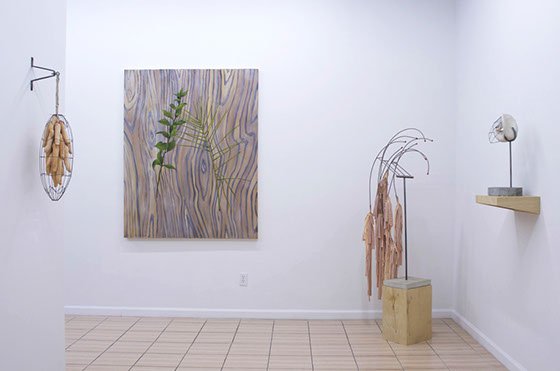
Natural Tendencies Installation shot, November 7 – December 7, 2014
photo: courtesy OUTLET
AJ: The gallery’s website talks about pushing the boundaries of curatorial practice, collaboration and exhibition design. Can you please illustrate how you push the boundaries? Can you also explain what is the value proposition that makes OUTLET unique?
JS: I do think OUTLET is unique because we are three curators with three different visions. We share a core sensibility and take every aspect of the business seriously, but we don't represent artists in the traditional way.. We push boundaries in the way that we work with a lot of different people and we try to promote artists' careers very specifically. Even though we don't have a huge staff to represent them, we try to get them into shows and events. We are open to a lot of mediums and to a lot of ways of putting shows together, which makes the whole approach be very organic. We try to partner with other galleries, which is also a way in which we are different, because we are not territorial. We take our clients and collectors to other galleries as well, so for us the whole process of being a gallery feels very collaborative, within ourselves and within a larger arts community. We are happy to share percentages with the [other] gallery in the event of sale. We take our clients and collectors to other galleries as well, so for us the whole process of being a gallery feels very collaborative, within ourselves and within a larger arts community.
AJ: It seems like the three J’s (John, Jason and Julian) have an important role in producing each show –given their artist backgrounds. How much of your own work do you reflect on each of the exhibitions? As practicing artists, how do you see running this space in relation to your respective practices?
JS: For me they are very separate. I am not exactly sure how Julian would answer that; he and I come from a background as maker of visual art. Jason comes from performing arts background. Julian and I both maintain a studio practice, but I would say that the interests we pursue in the studio do not necessarily translate to how we curate exhibitions. I think being an artist makes me more empathetic to other artists and I understand the real struggles of money, rent, and the vast amounts of time to produce art. Some of those things help me understand their process better –and not necessarily from a conceptual standpoint. One thing I have noticed is that I come from a very heavy and dominant background in photography, but I actually don't show a lot of photography. There are only a few photographers that I like and try to promote, but it's not generally what I'm drawn to when I am thinking as a dealer or as a curator.
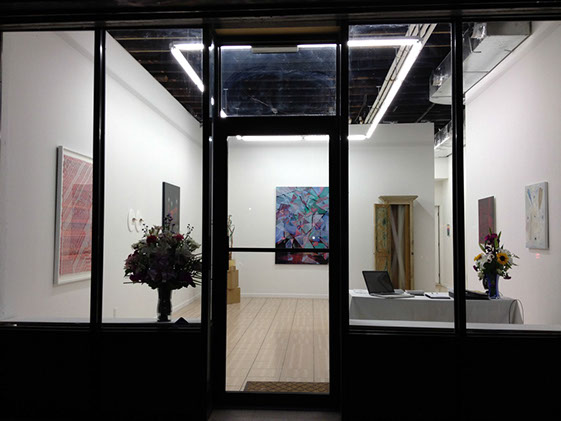
OUTLET Gallery
photo courtesy of John Silvis
AJ: Do you feel any responsibility with your artists? Since you know how artists are treated.
JS: Oh, absolutely! We try to be as helpful, supportive, and responsive as we can –within our means. The one rule that we have is that we pay our artists for their work as soon as we are able to. We often will deduct some productions costs if there is a high percentage of production involved. We try to absorb as much responsibility as we can. We also try to promote them a lot on our website.
AJ: Your current show titled Second Nature, features the work of two emerging artists, Julian Lorber and Mark Dorf. What qualities of their work interested you the most?
JS: Well, the current exhibition is curated by Julian, and they are two artists whom he had worked with in the past. Basically we take turns developing concepts and shows. I met Julian through a show we did last year as a part of Exchange Rates, called Altered Terrain. Initially I wasn't sure how to react to his work, but eventually I admired how he was able to work with surfaces and the sense of the form. I really like the way in which he works with color and contrast by employing these different airbrush techniques. It is a very strong and formal work.
With Mark, I was particularly interested in how he pulls ideas from other disciplines. He does a lot of research and studies about environmental theory, and that influences his practice greatly. Mark does a very interesting job of processing that data within these disciplines and then translating it into an engaging visual experience –which isn't always easy to do.
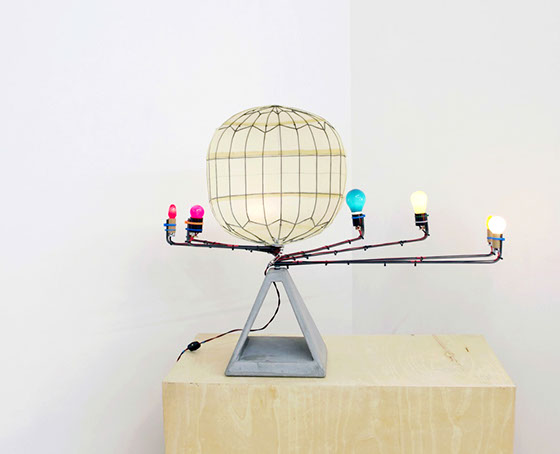
Natural Tendencies Installation shot, November 7 – December 7, 2014
photo: courtesy of OUTLET and Genesis Belanger
AJ: Are there any plans for future off-site shows? Will you be doing any art fairs anytime soon?
JS: Absolutely! We did our first off-site show last October as a part of Exchange Rates, called Altered Terrain. It was an exploration to work with international spaces. We are also doing the JustMAD6 art fair in Madrid, and have been in conversation with multi purpose spaces in Manhattan to do future shows. We definitely see OUTLET as a moving organism... There may even be opportunities overseas to do some shows with other cooperatives. All of that is still in process.
AJ: What do you think about the Art Fair Scene? Are you “fatigued” as everyone else? How do they affect your business?
JS: Well, we are doing our first art fair soon, so I guess we'll find out. I would say that for better or worse, art fairs are a really great intersection point for dealers, collectors AND artists. I think it really has facilitated a growth and more widespread interest in what is happening in the contemporary art scene. It makes what happens in the gallery much more visible to a larger audience. Maybe the core of serious collectors hasn't changed so much, but it has definitely made it more accessible to a larger audience.
Another thing I would say is –being that there are over fifty galleries in Bushwick who are all surviving and doing well– that this density and popularity would be possible without the proliferation of art fairs in the last ten years. The wave of interest has allowed even smaller spaces to show their programming. There is definitely more awareness in that sense, even in other parts of the country where there was no connection to the art world. In the mid-west and the south, the art market is now on people's radar.
AJ: There is a stigma that “artist run spaces are for artists only”. If anything, what have you done to change this notion? What kind of audience do you want to reach?
JS: One of our main goals is to contribute to our community and we feel like our responsibility is to sell the work and help artists pay their rent. Some artists are able to live quite well,
Second Nature: Mark Dorf and Julian Lorber at OUTLET Gallery, 2015
photo courtesy of Peter Freeby
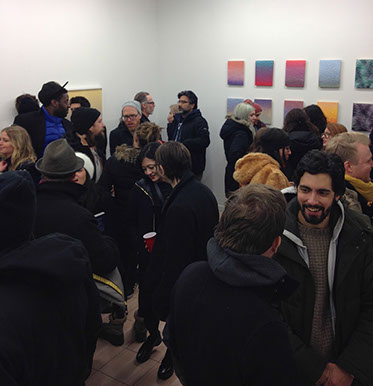
but most of them rely on some form of art income to keep their practice going. When we don't sell work I feel disappointed because in some ways I feel like we are not giving the artists enough or we could do more for them.
AJ: Do you feel a collector culture growing in Bushwick? What have you done to bring collectors out here? If anything, what can you predict about the art-scene in the neighborhood?
JS: Absolutely, I think it is changing. The Bushwick Open Studios have brought a lot of awareness to the neighborhood. I think it is still difficult to get higher end collectors and art advisors to come to Bushwick. And in some ways I totally understand it. With so many galleries and so many artists, it is really difficult to filter through and get a sense of what is important in the neighborhood or what might be interesting to their clients. For most people it is overwhelming and they would rather wait for it to filter into the Lower East Side or filter further uptown. The few collectors that I know that are really adventurous and want to be in the forefront are willing to come out and engage with what is happening in Bushwick. It's been exciting!
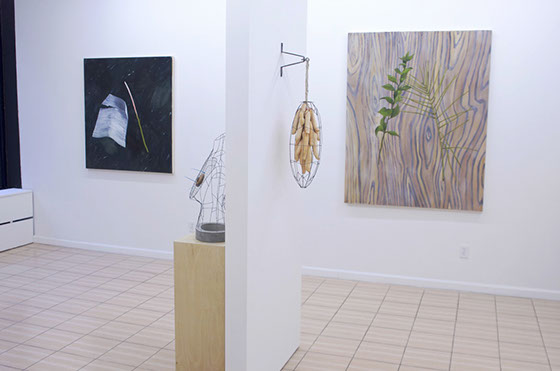
Natural Tendencies Installation shot, November 7 – December 7, 2014
photo: courtesy OUTLET
AJ: What can you predict?
JS: That is hard to say. I think the tendency historically is that when a gallery does well, they will move to the next best neighborhood. Most Bushwick galleries will try to move to the Lower East Side once they are more established... Maybe Upper East Side. That said, I don't think everyone has that vision, and I think that we, as a gallery, don't have to think about our trajectory that way. We are more interested in developing a stronger program, but we don't really talk about moving to another neighborhood. We like the autonomy of being in Bushwick, surrounded by a few good programs that operate on a more intimate scale.
AJ: What is in the horizon for OUTLET? How do you think it will evolve in the next few years?
JS: More than expanding our space, or participating in more shows, I would like to develop more of an international presence, meaning to go to international fairs, partnering with international galleries. I think it is possible now for emerging galleries to show emerging art from other countries. Art fairs were able to do that, but now local galleries with the proper network can do it. Our show Altered Terrain was very successful overall in attendance and critical response; for us it was also good financially. We feel confident that if we keep doing these international partnerships, it will just grow. Hopefully we will be able to show our artists overseas!
AJ: Who is an artist whose work/career you follow, someone that interests you that you don’t represent and what is it about their work that you respect?
JS: There are a couple of themes that keep me engaged in art. One of them is technology and the other is how artists work with fabrics, textile and weaving. I have also noticed that artists tend to be a lot more resourceful and approach their art from a standpoint of sustainability with materials that are easily degradable or recycled... in some way transformed. I don't think that all of them are conscious of that –some more than others. I have curated shows around that theme.
One artist that I have been interested in over the years is a New Zealand artist named Simon Denny. He shows with a lot of German galleries and spends a lot of time in Berlin. He is someone that I really find inspiring. He thinks about his work in a very global context.
Another one that comes to mind is Siebren Versteeg. He just had a recent show at James Cohan gallery; it was a group show called By Proxy.
AJ: And last, what is your go-to restaurant in Bushwick?
JS: AP Cafe and Northeast Kingdom, both owned and run by artists. A great example of being involved with the community!
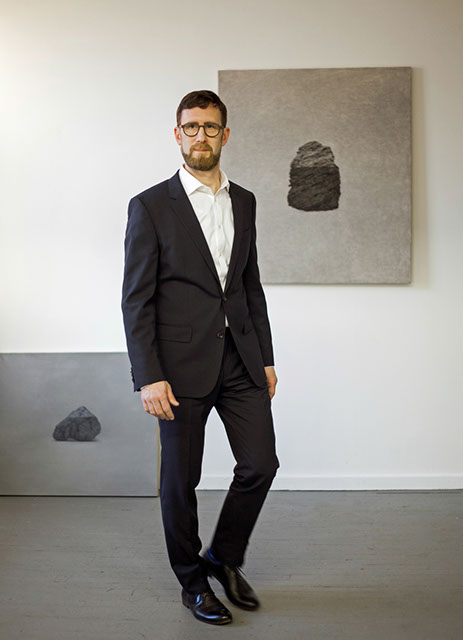
John SIlvis in his Williamsburg studio
photo: Andre Wagner
From the website:
JOHN SILVIS is a Brooklyn-based artist and curator. He received his MFA from the Academy of Fine Arts, Vienna and has received numerous grants and awards, including a commission for the Essl Collection in Vienna. Silvis’ recent art research has taken him to Beijing, Berlin and Zurich. Some recent exhibitions include “Crashcourse IV,” Norte Maar, “What I Know,” NYCAMS, New York (2012), “Crashcourse III,” Olson Gallery, Bethel University, MN (2012), and “Goodbye Space Shuttle,” Active Space, Brooklyn (2011). His recent curatorial projects include “New. New York,” Essl Museum, Vienna (2012), “1000 Rainbows,” Lia Chavez, First Things Gallery, New York (2012), and “Life Drawing,” Joshua Cave, First Things Gallery, New York (2013).
OUTLET Fine Art is an exhibition space in Brooklyn dedicated to presenting innovative and dynamic programming. We host monthly exhibitions and workshops designed to engage and inspire through a comprehensive arts experience. At the root of OUTLET, we believe in promoting creativity through exhibitions, collaborations, and out-of-the-box explorations.
Alejandro Jassan is a curator and critic from Mexico City. He currently lives and works in New York City.
Disclaimer: All views and opinions expressed are those of the authors and do not necessarily reflect the views of the editors, owner, advertisers, other writers or anyone else associated with PAINTING IS DEAD.

